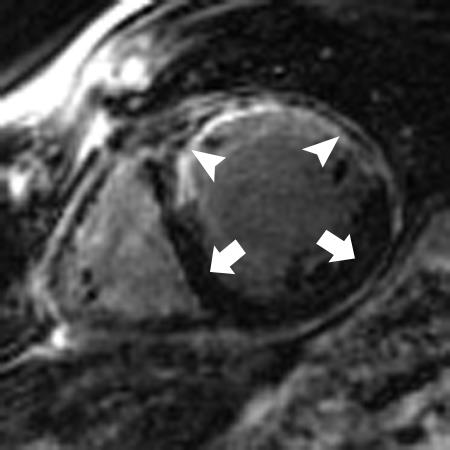

 The objective of this research is to develop free breathing cardiac magnetic resonance imaging for accurate and fast assessment of cardiac morphology, ventricular function, flow dynamics and myocardial characterization. Currently clinical cardiac MRI is performed using the breath-holding 2D acquisition approach, imaging the heart slice by slice through many repetitive breath-holds. The limitations of this breath-hold approach include inapplicability in dyspneic patients, poor image quality with problematic breath-holding, slice misregistration, indequate spatial resolution and volume coverage. The free breathing approach to address these breath-hold problems have been developed by us and others using the pencil beam diaphragm navigator. However, free breathing cardiac MRI is rarely performed in clincal practice, partly because cardiac navigator sequences have not been adequately developed, the diaphragm navigator does not measure heart motion directly, and current navigator scan time is too long. We propose to expand and optimize free breathing navigator cardiac MRI sequences. The cardiac fat navigator will be used to directly monitor motion of the heart. Navigator scan efficiency will be increased using the simultaneous mulitple volume approach. The scan time will be further shortened using multiple coil based parallel imaging. Upon successful completion, this research will lead to a fast and accurate free breathing cardiac MRI. In this five year research project, we will focus on developing navigator parallel imaging for two types of pulse sequences, eletrocardiogram-triggered segmented sequences (black blood fast spin echo and myocardial delayed enhancement) and cine sequences (cine phase contrast, and cine steady state free precession). These are the four most commonly used pulse sequences in our practice. Accordingly we plan to achieve the goal of fast accurate free breathing cardiac MRI through the following specific aims: 1. Develop cardiac fat navigator and integrated navigator parallel imaging for ECG-triggered segmented sequences. 2. Develop navigator parallel imaging for cine sequences. 3. Evaluate developed free breathing cardiac MRI in a cohort of cardiac patients. This research grant will develop fast free breathing cardiac MRI sequences using the navigator method and the accelerated parallel imaging method. It will overcome the limitation of current breath hold cardiac MRI. It will extend the benefit of cardiac MRI examination to patients with difficulty holding breath. It will improve the spatial resolution, spatial coverage, temporal resolution, and scan speed of cardiac MRI.
The objective of this research is to develop free breathing cardiac magnetic resonance imaging for accurate and fast assessment of cardiac morphology, ventricular function, flow dynamics and myocardial characterization. Currently clinical cardiac MRI is performed using the breath-holding 2D acquisition approach, imaging the heart slice by slice through many repetitive breath-holds. The limitations of this breath-hold approach include inapplicability in dyspneic patients, poor image quality with problematic breath-holding, slice misregistration, indequate spatial resolution and volume coverage. The free breathing approach to address these breath-hold problems have been developed by us and others using the pencil beam diaphragm navigator. However, free breathing cardiac MRI is rarely performed in clincal practice, partly because cardiac navigator sequences have not been adequately developed, the diaphragm navigator does not measure heart motion directly, and current navigator scan time is too long. We propose to expand and optimize free breathing navigator cardiac MRI sequences. The cardiac fat navigator will be used to directly monitor motion of the heart. Navigator scan efficiency will be increased using the simultaneous mulitple volume approach. The scan time will be further shortened using multiple coil based parallel imaging. Upon successful completion, this research will lead to a fast and accurate free breathing cardiac MRI. In this five year research project, we will focus on developing navigator parallel imaging for two types of pulse sequences, eletrocardiogram-triggered segmented sequences (black blood fast spin echo and myocardial delayed enhancement) and cine sequences (cine phase contrast, and cine steady state free precession). These are the four most commonly used pulse sequences in our practice. Accordingly we plan to achieve the goal of fast accurate free breathing cardiac MRI through the following specific aims: 1. Develop cardiac fat navigator and integrated navigator parallel imaging for ECG-triggered segmented sequences. 2. Develop navigator parallel imaging for cine sequences. 3. Evaluate developed free breathing cardiac MRI in a cohort of cardiac patients. This research grant will develop fast free breathing cardiac MRI sequences using the navigator method and the accelerated parallel imaging method. It will overcome the limitation of current breath hold cardiac MRI. It will extend the benefit of cardiac MRI examination to patients with difficulty holding breath. It will improve the spatial resolution, spatial coverage, temporal resolution, and scan speed of cardiac MRI.